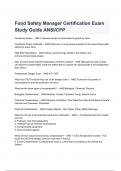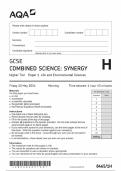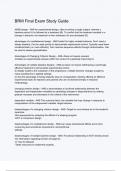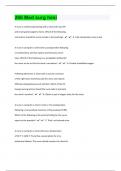Food Safety Manager Certification Exam
Study Guide ANSI/CFP
Foodborne Illness - ANS A disease carried or transmitted to people by food.
Foodborne Illness Outbreak - ANS When two or more people experience the same illness after
eating the same food.
High Risk Populations - ANS Infants, preschool age children, the elderly, and
immunocompromised people.
Why do some foods require temperature control for safety? - ANS Although any type of food
can become contaminated, some are better able to support the rapid growth of microorganisms
than others.
Temperature Danger Zone - ANS 41F-135F
Why must TSC Foods be kept out of the danger zone? - ANS To prevent the growth of
microorganisms and the production of toxins.
What are the three types of contaminants? - ANS Biological, Chemical, Physical
Biological Contaminants - ANS Bacteria, Viruses, Parasites, Fungi, Natural Toxins
Chemical Contaminants - ANS Cleaners, Sanitizers, Toxic Metal from Non-Food Service Grade
Utensils and Cookware, Pesticides
Physical Contaminants - ANS Foreign Objects - Hair, Glass, Paper, Metal Shavings.
What are the top 5 documented reasons for outbreaks? - ANS 1. Purchasing food from unsafe
sources
2. Failing to cook food adequately
3. Holding Food at incorrect temperatures
4. Contaminated equipment
5. Poor personal hygiene
What are four ways food becomes contaminated? - ANS 1. Time-Temperature Control ( TCS
foods are left in the danger zone for more than 4 hours.)
2. Cross Contamination (Contaminants cross to a food that is not going to be cooked any
further.)
,3. Poor Personal Hygiene (Food handlers cause foodborne illness.)
4. Poor Cleaning and Sanitizing.
Ready-to-Eat Foods - ANS Foods that can be consumed without further preparation, washing,
and cooking.
Examples of Ready-to-Eat foods - ANS Cooked food, washed fruit and vegetables, Deli Meat,
Bakery Items, Sugar, Spices, and Seasonings.
What measures should be focused on when training to keep food safe? - ANS Controlling time
and temperature, preventing cross-contamination, practicing good personal hygiene, purchasing
from approved reputable suppliers, cleaning and sanitizers.
What are some ways to train and monitor employees on keeping food safe? - ANS Train staff to
follow food safety procedures. Provide initial and ongoing training. Provide all staff with general
food safety knowledge. Provide job specific food safety training. Retrain staff regularly. Monitor
staff to make sure they are following procedure. Document training.
Food and Drug Administration (FDA) - ANS A federal agency that inspects all food except
meat, poultry, and eggs. It also regulates food transported across state lines.
U.S. Department of Agriculture (USDA) - ANS A federal agency that regulates and inspects
meat, poultry, and eggs. It also regulates food that crosses state boundaries or involves more
than one state.
What do agencies such as the Centers for Disease Control and Prevention and the U.S Public
health service do? - ANS Conduct research into the causes of foodborne-illness outbreaks.
What do state and local regulatory authorities do? - ANS Write or adopt code that regulates
retail and food service operations.
Foodborne Infections - ANS Result when a person eats a food containing pathogens which
grow in the intestines and cause illness.
Common Symptoms of Foodborne Illness - ANS Diarrhea, Vomiting, Fever, Nausea, Abdominal
Cramps, Jaundice
Onset times for foodborne illnesses - ANS Depends on the type of illness, can range from 30
minutes to 6 weeks or longer.
Foodborne Intoxication - ANS Result when a person eats food containing toxins (Poison)
produced by pathogens found in the food or which are results of chemical contamination.
, Bacteria - ANS Are of the greatest concern of the biological contaminants. Bacteria are found
everywhere and under favorable conditions they can reproduce very rapidly if FATTOM
conditions are right.
FATTOM - ANS Food, Acidity, Temperature, Time, Oxygen, Moisture.
Food in FATTOM - ANS Most bacteria need nutrients to survive. TCS food supports the growth
of bacteria better than other types of food.
Acidity in FATTOM - ANS Bacteria grow best in food that contains little or no acid on a pH Scale
that ranges from 0 to 14.0 acid to alkaline. Bacteria grow right in the middle more rapidly from
4.6-7.5
Temperature in FATTOM - ANS Bacteria grow rapidly between 41F and 135F this range is
known as the temperature danger zone. Bacteria growth is limited when food is held above or
below the temperature danger zone.
Time in FATTOM - ANS Bacteria need time to grow. the more time bacteria spends in the
temperature danger zone the greater chance they have to grow to unsafe levels. Bacteria
doubles every 15 to 20 minutes in the TDZ.
Oxygen in FATTOM - ANS Some bacteria need oxygen to grow, while others grow when
oxygen isn't there. (ROP)
Moisture in FATTOM - ANS The amount of moisture available in food is called water activity
(AW), the AW scale ranges from 0.0 to 1.0 the higher the value, the more available moisture in
the food.
What are the easiest things to control in FATTOM? - ANS Time and Temperature are the
easiest things for us to control.
What are the four types of bacteria that cause severe illness and are highly contagious as
identified by the FDA? - ANS Salmonella Typhi, Nontyphoidal Salmonella, Shigella spp,
Enterohemorrhagic and shiga toxin-producing Escherichia coli.
Characteristics of Salmonella Typhi - ANS -only lives in humans
-People with typhoid fever carry the bacteria in their bloodstream and intestinal tract.
-eating only a small amount of these bacteria can make a person sick.
-Severity of symptoms depends on the health of the person and the amount of bacteria eaten.
The bacteria are often in a person's feces for weeks after symptoms have ended.
Characteristics of Nontyphoidal Salmonella - ANS -Many farm animals carry naturally
-The severity of a person's symptoms depends on how much is eaten.
-Has been found in tomatoes, peppers, and cantaloupes.







